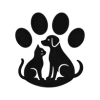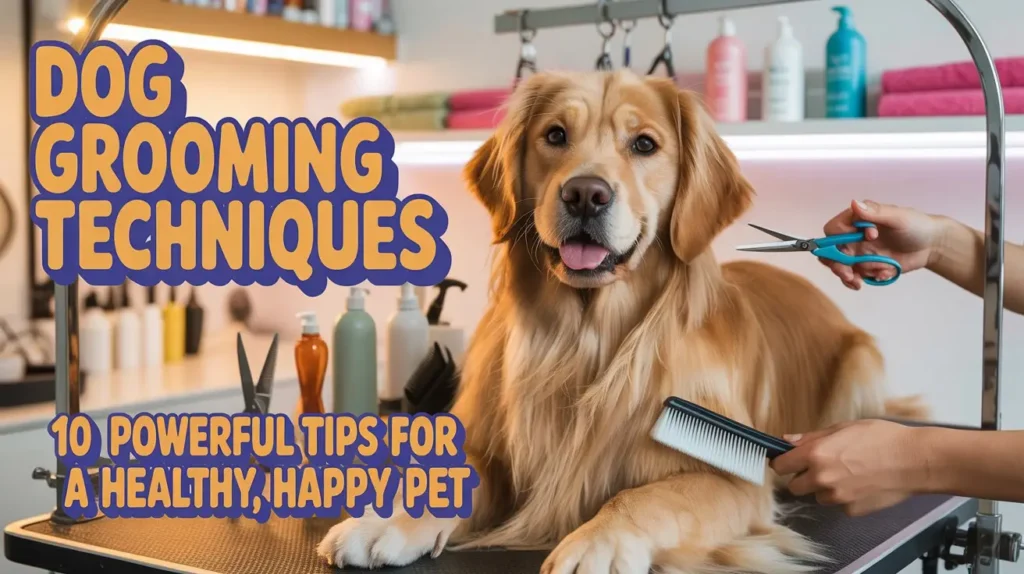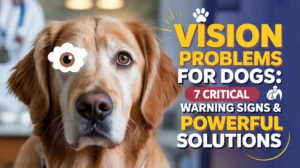Dog Grooming Techniques, an attractive appearance is not the only reason to keep your dog clean and healthy. The goal of grooming involves security together with hygiene and strengthening emotional bonds. The following guide provides expert dog grooming recommendations together with best practices for every dog breed. Dog grooming techniques, the home-based dog grooming instructions provided here work perfectly for pet owners of all experience levels.
Every Dog Owner Needs Fundamental Dog Grooming Techniques Awareness
Dog grooming techniques, all grooming principles need proper understanding before we explore breed-specific recommendations. For dog grooming you will require essential tools such as brushes, nail clippers, shampoo together with towels. The correct dog products exist only in products designed specifically for dogs. Certain human-designed products cause skin irritation when your dog gets in contact with them.
Dog grooming techniques, brush your dog regularly. Regular brushing takes loose hair away while it minimizes tangles and helps distribute natural oils throughout the coat. A dog’s grooming success greatly depends on selecting the correct brush type as an important grooming technique. Long-haired dogs need slicker brushes. Short-haired dogs benefit best from the usage of bristle brushes.
At Home Dog Grooming Techniques
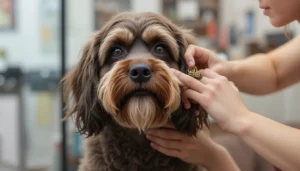
Most grooming tasks do not require professional assistance. Many dogs feel safer at home. Set up a calm space where you can follow this at home dog grooming approach. Wait for your dog to become relaxed before you give him the grooming session after playtime or your walk together. Always reward with treats.
A non-slip mat should be used as a precaution while bathing your dog in sink or tub areas. Position all grooming equipment directly in front of you. These straightforward at home dog grooming techniques will both support a soothing experience for everyone involved.
Dog Bathing Tips for a Clean Coat
Dog grooming techniques, a healthy dog coat exists when it remains free from dirt and debris. Use lukewarm water. Begin by soaking your dog completely before putting on shampoo. Choose a dog-friendly shampoo. Apply shampoo thoroughly across the body without getting it near the eyes or ears. Rinse thoroughly. Performing post-bath drying emerged as the most forgotten aspect among dog bathing advice. Apply a towel before using a low-heat blow dryer on your dog when they permit the drying procedure.
Short coats may dry quickly. Long-haired breeds need extra care. Due to the risk of tangles it is vital to brush your dog right after their bath.
Dog Grooming Techniques for Dog Nail
Your dog’s nails need to be of appropriate length to avoid pain together with improper posture. These following dog nail trimming tips provide protection during the clipping process. Use a sharp, pet-specific clipper. Cut small bits at a time. Cutting the nail in the pink inner area of a toe is harmful — this delicate section is known as the quick. A quick stop of bleeding requires you to apply styptic powder when you accidentally cut their nails.
Pet Groomer Tips for Better Results
Pet owners should trim just one paw of anxious dogs each day. The dog nails clipping tips help beginners perform this task with less fear and greater control.
Pet Groomers Generate Improved Grooming Outcomes Through the Following Tricks
Experienced groomers possess techniques which they use to achieve better results. These following pet groomer techniques provide homeowners with professional-grade outcomes when grooming their pets at home. Pet groomers should brush the dog before bathing so you can eliminate any existing mats. Dog grooming should based on brief interactions that remain consistently pleasant. The most effective way to talk to a dog is by using a steady and pleasant tone in your voice. Regular practice builds trust.
If you wish to enhance your dog grooming abilities then read on. You can learn from watching online tutorials or attend a single visit to a groomer for advice.
Dog Grooming Techniques for Golden Retriever
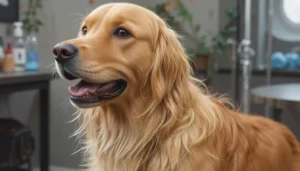
Golden Retrievers shed a lot, daily brushing is key. Slicker brushes are useful for extracting dead hair. Elegant golden retriever appearance results from trimming the feathering hair around their legs and tail according to expert recommendation. The cleaning of the ears needs to be done weekly as prevention against infections.
Bath them every 4-6 weeks. Dry them entirely since the thick coat retains water.
Dog Grooming Techniques for Goldendoodles
The coat of Goldendoodles is dense and curly by nature so it tends to form heavy knots. Regular brushing is essential. The smartest grooming process for goldendoodles includes brushing the hair in sections. This method prevents any area from remaining unattended during grooming.
It is critical to trim both paws and eyes to improve vision and comfort. Periodic baths paired with expert professional cuts occurring once every 6 to 8 weeks will help their appearance stay healthy.
Dog Grooming Techniques for Poodles
Poodles require special care. The unique shape of their curling coat enables fast accumulation of dirt as well as mat formation. Daily brushing is best. The grooming tips for poodles recommend periodic hair cuts during a 4 to 6 week period. The teddy bear and continental clip designs offer you some alternatives for creative poodle haircuts.
Keep ears dry and clean. Natural care for poodles demands regular attention to their ear health because ear infections commonly affect this breed.
Dog Grooming Techniques for Shih Tzu
Shih Tzu dogs naturally possess coats which effectively reach their lower body parts. The essential advice for grooming shih tzu puppies is to brush them daily. Apply detangling spray only when necessary. Trim the region surrounding their eyes frequently as it is one of the most important grooming tips for Shih Tzu.
Regular bathing sessions maintain the shine of their coat. Complete drying of the coat should follow bathing to stop fungus growth and mat development.
Dog Grooming Techniques for Labradoodle
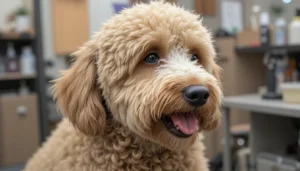
Labradoodles have two potential coat types including wavy or curly. Regular brushing of these breeds should happen three or four times each week. The most important aspect of labradoodle grooming involves using both a de-matting tool combined with a slicker brush.
Bath monthly and check ears for wax buildup. Cutting the fur between paws will improve both grip and comfort and hygiene.
Dog Grooming Techniques for Bichon
Bichons need frequent grooming. Their fluffy white coat mats quickly. The central rule for bichon grooming involves daily brushing and weekly bathing. Apply whitening shampoos for achieving brighter coat appearance.
Regular trims will help preserve the typical round appearance of your facial shape. Daily clearing of eyes helps stop tear stains from developing.
Dog Grooming Techniques for Miniature Schnauzer
Owners must pay attention to the double coat which exists naturally on Schnauzers. Following this miniature schnauzer grooming guide will provide the best outcomes. Brush at least twice a week. Trim their distinctive facial hair along with eyebrow area.
You should maintain coat texture through hand-stripping while clippers also work as an alternative method. Clean ears and brush teeth weekly.
Learning Dog grooming techniques require both dedication along with continuous patience during the learning process. The correct approach makes dog grooming into an enjoyable experience. The methods provided for home grooming your dog will help create a strong bond between you while maintaining your pet’s handsome appearance.
Mode on the conducted dog grooming treatments should include regular application of the provided tips while maintaining home-based care for your dog. Each dog breed demands specific maintenance starting from golden retriever directions and proceeding to poodle instructions.
You will need to have your grooming brush as well as treats together with tools at hand. Turn grooming into bonding time. You will obtain a neat and enthused canine friend who wishes to wag its tail.
Frequently Asked Questions:
1. What are the essential dog grooming techniques every owner should know?
The basic techniques are brushing, bathing, nail trimming, and ear cleaning. Regular grooming helps keep your dog healthy, clean, and comfortable.
2. How often should I groom my dog at home?
It depends on your dog’s breed and coat type. Most dogs need brushing every week and a bath once a month. Long-haired dogs may need more frequent grooming.
3. What tools do I need for at-home dog grooming?
You’ll need a dog brush, nail clippers, dog shampoo, grooming scissors, and a towel. You can also use a detangling spray and a blow dryer if needed.
4. What are the best tips for grooming your dog at home safely?
Keep grooming sessions short and calm. Reward your dog with treats. Always use pet-safe products and tools, and make the experience relaxing.
5. How do I avoid cutting the quick when trimming dog nails?
Trim only a small bit at a time and make sure there’s good lighting. Look for the pink part inside the nail — that’s the quick. Stop trimming before you reach it.
6. What are some grooming tips for dogs with curly or thick coats?
Brush your dog every day to prevent mats. Use a slicker brush and bathe your dog every 4–6 weeks. Curly-haired breeds like poodles and doodles also need regular trimming.
7. Are there specific grooming tips for small breeds like Shih Tzus or Bichons?
Yes. Brush them often, trim the hair around their face, and clean their eyes every day. Keep their coat smooth and tangle-free with regular care.
8. When should I consider using a professional pet groomer?
Go to a professional groomer if your dog’s coat is hard to manage, if your dog doesn’t behave well during grooming, or if the breed needs a special haircut.
